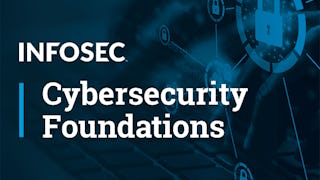Filter by
SubjectRequired
LanguageRequired
The language used throughout the course, in both instruction and assessments.
Learning ProductRequired
LevelRequired
DurationRequired
SkillsRequired
SubtitlesRequired
EducatorRequired
Explore the Linux Commands Course Catalog
 Status: Free Trial
Status: Free TrialDartmouth College
Skills you'll gain: C (Programming Language), Linux, Embedded Systems, System Programming, Build Tools, Command-Line Interface, Operating Systems, Program Development, Software Installation, Development Environment, Application Development, File Systems

Peking University
Skills you'll gain: File Systems, Operating Systems, OS Process Management, Computer Systems, System Programming, Unix, Linux, Algorithms, Virtualization

Amazon Web Services
Skills you'll gain: Command-Line Interface, Network Troubleshooting, Linux Commands, Linux, Linux Administration, Technical Support, Network Infrastructure, Amazon Web Services, File Management, Network Security, System Configuration, Software Installation
 Status: Free Trial
Status: Free TrialSkills you'll gain: Full-Stack Web Development, Restful API, Django (Web Framework), Relational Databases, Version Control, SQL, Unix Commands, Git (Version Control System), GitHub, Database Design, Responsive Web Design, Database Management Systems, Front-End Web Development, Algorithms, MySQL, Bootstrap (Front-End Framework), Test Driven Development (TDD), Unit Testing, Pseudocode, Web Development
 Status: Free Trial
Status: Free TrialInfosec
Skills you'll gain: Penetration Testing, Cyber Security Policies, Linux Commands, Cyber Security Assessment, Command-Line Interface, Cybersecurity, Cloud Computing, Linux, Risk Management Framework, Network Monitoring, Security Management, Operating Systems, Cyber Risk, Threat Management, Vulnerability Assessments, General Networking, Windows PowerShell, Cyber Governance, Microsoft Windows, Virtual Machines
 Status: Free Trial
Status: Free TrialSkills you'll gain: React Native, User Research, UI/UX Research, Persona (User Experience), Restful API, Design Research, Android Studio, Version Control, Kotlin, User Experience Design, Android Jetpack, Unix Commands, Android Development, Interaction Design, Git (Version Control System), GitHub, Algorithms, Jest (JavaScript Testing Framework), Usability, Mobile Development

Skills you'll gain: Networking Hardware, General Networking, Network Architecture, Wireless Networks, Network Protocols, Computer Networking, TCP/IP, Local Area Networks, Network Routers, System Configuration, Network Switches, Wide Area Networks, Servers

Coursera Project Network
Skills you'll gain: Bash (Scripting Language), Systems Administration, Shell Script, Linux Commands, Linux Administration, Linux, Unix, Scripting, Scripting Languages, Unix Commands, IT Automation, File Systems
 Status: Free Trial
Status: Free TrialDuke University
Skills you'll gain: Technical Communication, Cloud Infrastructure, CI/CD, Cloud Computing, Agile Software Development, DevOps, Infrastructure As A Service (IaaS), Cloud Platforms, Continuous Delivery, Infrastructure as Code (IaC), Serverless Computing, Software Development, Continuous Integration, Amazon Web Services, Software Development Methodologies, Platform As A Service (PaaS)
 Status: Free Trial
Status: Free TrialSkills you'll gain: Cloud Computing, Cloud Infrastructure, Cloud Services, JavaScript Frameworks, Back-End Web Development, DevOps, Full-Stack Web Development, OpenShift, Version Control, Cloud Development, CI/CD, Software Development, Cloud-Native Computing, Web Applications, Microservices, Containerization, Kubernetes, Web Development, Serverless Computing, Docker (Software)
 Status: Free Trial
Status: Free TrialCisco Learning and Certifications
Skills you'll gain: Threat Modeling, Threat Detection, Cyber Operations, Cybersecurity, Security Information and Event Management (SIEM), Incident Response, Security Management, Computer Security Incident Management, Cyber Attacks, Event Monitoring, Network Monitoring, Automation
 Status: Free Trial
Status: Free TrialSkills you'll gain: OpenShift, Kubernetes, Cloud-Native Computing, Application Deployment, Cloud Applications, Containerization, Scalability, Cloud Management, Development Environment, Docker (Software), Cloud Computing, Platform As A Service (PaaS), Cloud Development, Continuous Deployment, YAML, Configuration Management, Network Routing, PostgreSQL, Performance Tuning, Command-Line Interface
Linux Commands learners also search
In summary, here are 10 of our most popular linux commands courses
- C Programming: Using Linux Tools and Libraries - 7: Dartmouth College
- 操作系统原理(Operating Systems): Peking University
- Cloud Support Essentials: A Technical Approach: Amazon Web Services
- Desarrollador back-end de Meta: Meta
- Cybersecurity Foundations: Infosec
- Desarrollador de Meta de Android: Meta
- Introduction to Contemporary Operating Systems and Hardware 1b: Illinois Tech
- The Bash Shell and Basic Scripting in Linux: Coursera Project Network
- Cloud Computing Foundations: Duke University
- Full Stack Software Developer Assessment: IBM










